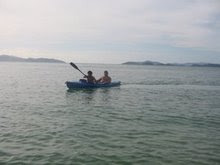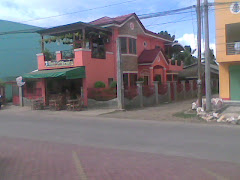We did not have a recollection last month (February) because Fr. Jim had a biking accident on February 6th, the day before he was supposed fly to Puerto Princesa. Everyone is keeping him in mind.
Last February 13, Pok Estrella and his wife, Marga, and daughter, Risa, arrived in town for a weekend vacation. Pok is a supernumerary whom Sam and I have known since our U.P. days (our frat-brod), before we all got into the Work. In 1999, he brought Fr. Jong Sabandal to Puerto Princesa to give the very first recollection by a priest of the Work in
On February 21, Fr. Eugene Elivera celebrated the 8th anniversary of his sacerdotal ordination with a Mass at the Immaculate Conception Cathedral. He is finishing his doctorate in Moral Theology at the
Henry flew in on the afternoon of February 26 (instead of the 21st) for Bong’s oblation that evening which was witnessed by Sammy, Orphy, and myself, in Henry’s room at Circon Lodge. To celebrate the occasion, we proceeded to Ardent Suites for dinner. Henry flew back to
Today, March 4, 2009, is the 137th anniversary of the foundation of the town of
The City Government has tried all sorts of catchy descriptions for Puerto Princesa: as the country’s “cleanest and greenest city”, “sports tourism capital”, a “pro-life and pro-family city” (for “one brief shining moment”, ha-ha-ha)—and now, on the heels of being declared a “highly-urbanized city” (a heartier ha-ha-ha!), as “a city in the forest” (an HUC in the stone age, ha-ha-ha). In fact, a more honest and honorable distinction would be that of being “founded by a saint”, because one of the founders—signatory to the “acta” establishing the town—was Saint Ezequiel Moreno, O.A.R., who was the chaplain of the expedition that arrived in Puerto Princesa on March 4, 1872.
The Palawan mainland was one of the last areas to be settled by the Spanish authorities (outside of
Fray Ezequiel was born in Alfaro, La Rioja,
In 1910, and again, in 1975, the remains of Fray Ezequiel were exhumed and found incorrupt; and with miraculous cures attributed to his intercession, he was beatified on November 1, 1975, and canonized on October 11, 1992. St. Ezequiel Moreno is known as patron saint of cancer patients and his feast is on August 19.
How many towns in the country, and even in the world, can boast of a canonized saint among its founders? We will only know the full import of these connections at the end of time; but even now, it is remarkable that the message of St. Josemaria is being preached in Puerto Princesa at a conference center named after his compatriot, St. Ezequiel, operated by nuns who claim close family relations with both. The “communion of saints” can be palpable at times.






































No comments:
Post a Comment